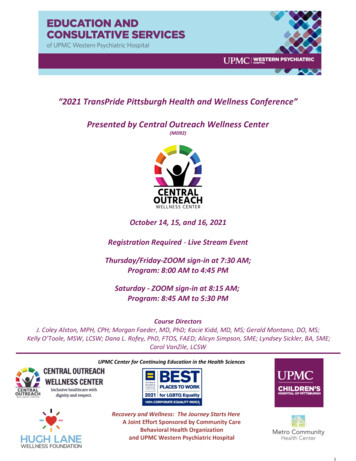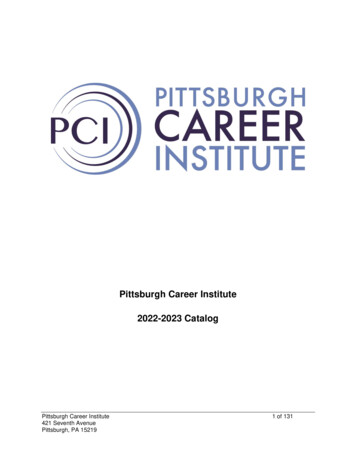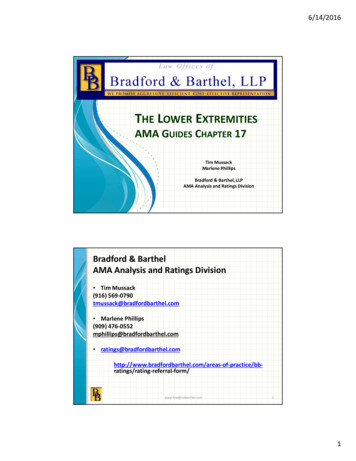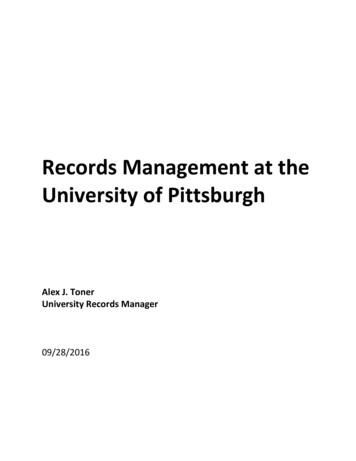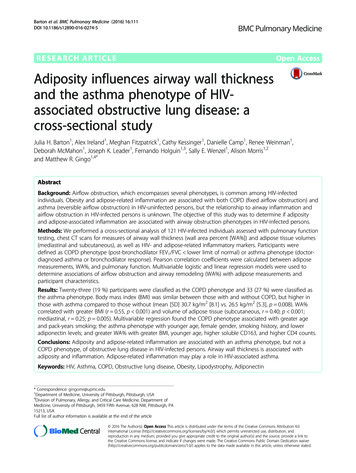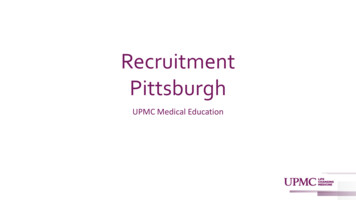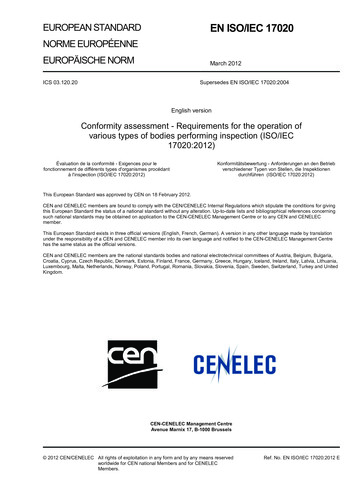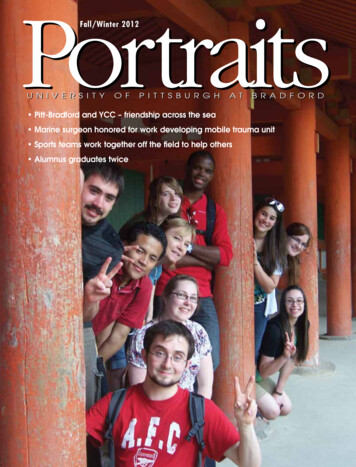
Transcription
PortraitsFall/Winter 2012U N I V E R S I T YO FP I T T S B U R G HATB R A D F O R D Pitt-Bradford and YCC – friendship across the sea Marine surgeon honored for work developing mobile trauma unit Sports teams work together off the field to help others Alumnus graduates twice
PRESIDENT’S MESSAGEPitt-Bradford remains on the right trackDear Friends and Supporters:The return of alumni during the recentAlumni and Family Weekend reinforcedthe notion that alumni are part of thelifeblood of a college or university and that noinstitution can expect to thrive without the activeengagement of alumni with currently enrolledstudents and their families and with faculty, staffand prospective students. At no time during theweekend was the engagement of our alumni moreimpactful than when the Alumni AssociationBoard introduced its new five-year strategic plan.Developed with the intent to complementour campus’s existing strategic plan, the AlumniAssociation plan endeavors to engage and enrichalumni and students, promote and advance theinterests of Pitt-Bradford and encourage alumnisupport for Pitt-Bradford’s capital campaign. Association Board members unanimously and enthusiastically embraced the plan, which includessuch impressive actions items as continuing theexpanding of the Student Alumni Associationdinner with a Panther program, in which alumnitake students to dinner; creating a job shadowingprogram for students; establishing a partnershipbetween the Career Networking Luncheon andthe Executive Speaker Series; co-hosting alumniat Pitt athletic events; participating in PittAdvocates and Pitt Day in Harrisburg; andidentifying fundraising opportunities for the50th Anniversary Scholarship.It didn’t take the association long to beginimplementation of the plan. One of the kick-offevents for Alumni and Family Weekend was thecaptivating presentation by alumnus, Doug Kuntz’88, who serves as president/CEO of Pennsylvania General Energy. The speech by Doug oncareer opportunities in natural gas productionwas the inaugural offering in the partnership ofthe longstanding Career Networking Luncheonand the Executive Speaker Series. One eyeopening revelation from the speech was thatcareer opportunities in the natural gas productionindustry span a broad range of fields from themore specialized extraction applications to information systems and traditional business fields.Doug’s presentation is prompting students whohad previously dismissed the natural gas industryas a career destination to now consider what thenatural gas industry might have to offer them.As we close in on our 50th anniversary andbegin to take stock of the impact of our presence inNorthwest Pennsylvania, a recent economic andcommunity impact study provides the data that willhelp us explain the nature of our impact, particularlyin terms of our alumni. Although Pitt-Bradfordalumni reside in all 50 states, about one-third(or 3,000) of our alumni live in our six-county serviceregion. They occupy positions of authority in someof the largest businesses and organizations in theregion and contribute immensely to the economicstability and long-term health and welfare of theregion. Doug who leads a major oil and gas producing corporation, is only one of many alumni movingthe region forward. I invite you to read about anotheraccomplished alumnus, Sean Barbabella ’92, whoseeffort to create a mobile trauma unit to quickly treatsoldiers wounded in combat is detailed in this issueof Portraits.Finally, we’re currently upgrading our website andwill, in the near future, launch the new site, whichwill feature exciting new ways to stay in touch withour campus. I hope you’ll stay connected throughthe website until the next time you visit the campus.As always, I thank you sincerely for your continuingsupport.Warmest regards,Livingston AlexanderPresidentOn the coverPitt-Bradford students ham it up for apicture at the Kasuga Grand Shrine inNara, Japan, part of a three-week tripled by Kristin Asinger, visiting instructorof sports medicine, and hosted byPitt-Bradford’s sister college in Japan,Yokohama College of Commerce.Pictured are, from front to back, JamesSegee (kneeling), Nick Swede, DanielMaldonado, Katie Zapel (kneeling),Asinger, Erica Maclean, Brian Roberts(leaning against pole), Heidi Pappert,Nyssa Brumagin and Megan Truman.For more on the 14-year partnershipbetween Pitt-Bradford and YCC, seepage 2.
PortraitsSenior EditorPat Frantz CerconeEditorKimberly Marcott WeinbergCopy EditorsJudy Hopkins ’71-’73Shelley PalmerMartha SimmonsAlumni EditorLindsay Hilton Retchless ’98DesignerNu*Ideas AdvertisingPhotographersSteve AllenAlan Hancock ’07Glenn Melvin ’04Shawn Murray ’01Kimberly Marcott WeinbergPrinterDual PrintingPublished by theOffice of Communications and MarketingUniversity of Pittsburgh at Bradford 2012www.upb.pitt.eduNONDISCRIMINATION POLICY STATEMENTThe University of Pittsburgh, as an educational institution and as anemployer, values equality of opportunity, human dignity, and racial/ethnicand cultural diversity. Accordingly, as fully explained in Policy 07-01-03, theUniversity prohibits and will not engage in discrimination or harassment onthe basis of race, color, religion, national origin, ancestry, sex, age, maritalstatus, familial status, sexual orientation, gender identity and expression,genetic information, disability, or status as a veteran. The University alsoprohibits and will not engage in retaliation against any person who makesa claim of discrimination or harassment or who provides information in suchan investigation. Further, the University will continue to take affirmativesteps to support and advance these values consistent with the University’smission. This policy applies to admissions, employment, access to andtreatment in University programs and activities. This is a commitment madeby the University and is in accordance with federal, state and/or local lawsand regulations.For information on University equal opportunity and affirmative actionprograms, please contact: University of Pittsburgh, Office of AffirmativeAction, Diversity and Inclusion, Carol W. Mohamed, Director (and Title IX,504 and ADA Coordinator), 412 Bellefield Hall, Pittsburgh, Pa., 15260(412) 648-7860.In compliance with the Family Education Rights and Privacy Act of 1974,the University guarantees that students have the right to inspect all personally identifiable records maintained by the institution and may challenge thecontent and accuracy of those records through appropriate institutionalprocedures. It is further guaranteed by the University that student recordscontaining personally identifiable information will not be released except aspermitted by the Family Education Rights and Privacy Act.Liza GrevilleHolly SpittlerLizbeth MatzAssistant to the President(814) 362-5121Associate Dean of Student Affairs(814) 362-7651Associate Professor of Business Management(814) 362-7639CONTENTSFriendship between sister schools 2Professor returns battle flag to familyCampus History 6Campus creatures from cute to blood-curdlingCampus News 8Faculty and staff notesAlumni weekend photo spreadReport of the president 13Honor roll of donorsAlumni Profile 34Alumnus Sean Barbabella ’92 keeping soldiers safeSports Zone 36Panther athletes have big heartsClass Notes 38In His Own Words 40Alumnus graduates from Pitt-Bradford -- twiceCorrectionA photo of ThetaDelta Sigma in thespring/summer issueof Portraits incorrectlyidentified one of thesisters. Correctly, thewoman shown wasJessica (Fairman) Hill’04, not ErickaThomas ’07.P O R TPROARI TT RS A I CT OS N TTEI NT TL SEFAL L /WI NT ER20121
FEATUREFinding a friend in a bPitt-Bradford’s sister college relationship with a Japanese institutBY KIMBERLY WEINBERGPortraits editorIt would have been easy to throw it out – thatfirst odd piece of correspondence from Japanthat showed up at Pitt-Bradford in 1993.Dr. Carol Baker, then dean of academic affairs,was used to the odd requests that came in the mail(email was just coming into vogue) and positivelypursued very few of them.This one was from a professor at YokohamaCollege of Commerce, Sadao Hashimoto, whowanted to do research and teach at Pitt-Bradford.“Something about the request piqued myinterest,” she said. “It somehow seemed sincere,and I confirmed that he was really interested inus (as opposed to mistaking Pitt-Bradford for thecampus in Pittsburgh), and he said he could teacha course in Japanese.”Hashimoto arrived that fall, worked on hisbook “English 30 Days” and taught a class in basicJapanese. He continued to visit, and during thesevisits, he and Baker began to discuss a closer, moreformal, agreement between Pitt-Bradford andhis own school, a business college serving about1,500 students, tucked away on a hillside inYokohama, the second-largest city in Japan.Some 14 years after a formal sister collegeagreement was signed by Pitt-Bradford and YCCin 1998, the relationship between the small collegein the wooded mountains of Pennsylvania and itscosmopolitan sibling a world away has matured.Existing at first as a one-way exchange in whichJapanese students visited Bradford to improvetheir English language skills and immersethemselves in the American culture, therelationship now goes both ways. Students andfaculty now travel annually between the East andthe West with the comfort of a home base on eachside of the world.Several YCC professors have followedHashimoto to Pitt-Bradford, living in a house onthe edge of campus, conducting research andteaching Pitt-Bradford students language, cultureand sometimes more.2P ORT R AIT STF EI TA LT EU R EF A LF LA /L WL I/ NW TI EN RT E 2R0 12 20 1 2
ig worldion has come of ageDr. Gautam Mukerjee, associate professorof economics, learns a Japanese gamefrom Morio Arimoto, right, during one ofPitt-Bradford’s Cultural Festivals.This spring, Dr. Don Ulin, associate professorof English, was the first Pitt-Bradford professorto teach at YCC, although several had precededhim and conducted research in Japan.Ulin, who specializes in British literature,had no background in teaching English as aSecond Language other than what he had readas preparation. The students’ backgroundsand abilities varied widely – more than he hadthought they would.He taught two classes, conversationalEnglish, in which he taught games, songs andsimple conversation skills, and literature.Literature was a greater challenge, he said.Ulin worked with a publisher to find a simplereader and tried to teach works that wouldincorporate a bit of history and Americanculture as well as literature, such as WaltWhitman’s elegy for Abraham Lincoln, “OhCaptain, My Captain.”He eventually came upon a formula in whichhe sat in a circle with the students and reada paragraph of a story. He would then havea student re-read the paragraph and explainanything the students needed help with.Having taken much of the semester todevelop that method, Ulin said he would loveto return to teach at YCC now that he has abetter idea of how to best instruct the studentsthere.While in Japan, Ulin was hosted by Dr.Morio Arimoto who also made his ninth tripto Bradford this summer, escorting a newgroup of Japanese students in the SummerP O RP TO RR AT IRTASI T SF E ATTI UT RL EFAL L /W I NT ER 20123
FEATUREFumio Kobayashi, a member of the YCC faculty, teaches Pitt-Bradford students the art of ikebana (flower arranging) during their trip to Japanthis spring. Kobayashi has also been a visiting professor at Pitt-Bradford, where he taught Japanese language and culture.Intensive English Program.Arimoto’s first trip to Bradford was in 1999,when, as dean of student affairs for YCC, hetraveled with the first group of 14 Japanesestudents to Pitt-Bradford. Since then, he alsohas played host to Pitt-Bradford faculty andstudents as they traveled to YCC for researchand to learn about Japanese culture.“There are different kinds of students inthe intensive English program,” he said ofthose he has brought to campus. “Some wantto improve their English. Some just want toexperience America. They are very interestedin American culture and life.”Keigo Omura, a business student fromYokohama, came with Arimoto this year onthe two-week trip and was clearly interestedin American culture. He dressed almost tooAmerican – like a parody of a hip-hop video –entirely in black with a snapback hat embroidered in gold, track jacket, T-shirt, large goldcross, long plaid shorts and sports slides withlong socks. He says he would like to studyEnglish and American culture and the character of Americans.4PP OO RR TT RR AA II TT SSTF IE TA LT EU R FE A LF LA/ LWL I / NWT I ENRT E2 R0 1220 1 2Fourteen years after aformal sister collegeagreement was signed byPitt-Bradford and YCC in1998, the relationshipbetween the small collegein the wooded mountainsof Pennsylvania and itscosmopolitan sibling aworld away has matured.The Japanese and American students havemore in common, however, than a few wardrobeelements and a smattering of English. AlthoughYCC has only three business-related majors tochoose from, many of its students live with theirfamilies and commute to school and work tohelp pay for their tuition and their participationin SIEP.This year brought more interaction betweenPitt-Bradford and YCC students to the summerprogram. Several Pitt-Bradford students who hadtraveled to Japan in the spring returned to campusto accompany the Japanese students on trips andoutings and give them people their own age tocommunicate with.The YCC students who come each summergenerally arrive in mid-August and spend a weekin Bradford, spending time at people’s homes, taking English lessons from Gary Tessmer, assistantprofessor of composition, visiting Niagara Falls,and enjoying iconic American experiences likeshooting at the Bradford Gun Club, whitewaterrafting, riding a horse and fishing in a pond.Cheryl Lutz ’71 and her husband, Rick, hostthe students for a dinner each year featuring a
Family Artifact Returned to Japanese Familysmoked meal, bonfire and s’mores (somethingthe students often don’t care for, thinking they’retoo sweet).“It’s very interesting to have them visit,” shesaid. “It’s fun. They now have Pitt-Bradfordstudents come with them. I observe more thananything else – how they can communicatewithout having a common language. They justseem to connect. It’s fun to watch.”The students were also treated to a picnicand swimming at the home of Samila Sosic ’11,who visited Japan on a Pitt-Bradford trip led byIsabelle Champlin during the spring of 2009.Sosic, Champlin, retired assistant professor ofanthropology and director of international studies, and her successor, Kristin Asinger, who isalso a visiting instructor of sports medicine, saidArimoto and the other Japanese professors whohave come to Pitt-Bradford are generous hosts.Dr. Don Ulin, right, and members of the Ito family gather around a Japanese battle flagcarried into battle by their ancestor, Ryozo Ito. From left are Haruni Ito, Koichi Ito(Ryozo’s grandson), Hisako Ito (Koichi’s mother), Dr. Fumio Kobayashi (YCC professorwho helped return the flag to the Ito family), Ryota Ito (Koichi’s son), and Ulin’s children,Alex and Colin.TSIEP 2012 – YCC students visiting with theSummer Intensive English Program get areal taste of America while visiting thehome of a Bradford resident and herhorses. (Photo by Alan Hancock ’07)This spring, Asinger took Pitt-Bradford’s largest group of students so far to Japan. Arimotoset up their itinerary and played the part oftour guide.“My idea is to show them Japanesetraditions and also current Japan and let themcommunicate with Japanese people,” Arimotosaid.The communication, he has found, iskey, even if it’s sketchy. When he brings hisurbanite students from Yokohama, visitingNew York City is one of the major draws forthe trip to America – it is the place they cannotwait to go to.“They really want to visit New York City,”he said, “but after coming back to Japan, theyalways say they wanted to spend more time inBradford. As long as they are in Bradford, theyare getting in touch with people and doingthings in the outdoors.”hanks to the partnership betweenPitt-Bradford and the YokohamaCollege of Commerce, a family artifacthas been restored to the family of a Japanesesoldier who fought in World War II.Dr. Don Ulin, associate professor of English,found an envelope in his father’s attic markedonly with “left by a Japanese soldier onMorotai.” Inside was a silk Japanese flag withwriting on it.Ulin’s father, now in his 90s and alwaysreluctant to talk about his role in World WarII, could not remember how he came to havethe flag, although Ulin knows he served in abomber squadron stationed in the Philippines.The battle for Morotai was part of the Alliedforces’ campaign to retake the Philippines. TheAllies met little resistance from the Japaneseon Morotai. Presumably, the flag was leftbehind in a hasty retreat.When he found the flag, he showed it toa colleague, Dr. Fumio Kobayashi, a YCCprofessor who was teaching at Pitt-Bradfordduring the 2010-2011 academic year.Kobayashi translated the writing on theflag as “Good luck in battle and come homesoon” along with a list of names. It was common for Japanese soldiers of the era to carrysuch flags into battle. Kobayashi said thatthere was a name of a town on the flag.Kobayashi’s curiosity was now piquedas well as Ulin’s. First Kobayashi had todetermine the new name of the town, sincemany Japanese towns changed their namesafter the war. Then he contacted descendantsof those named on the flag before findingthe grandson of Ryoto Ito, who had returnedsafely from the war, but who had died in1969.Ulin decided that when he traveled toJapan this spring to teach at YCC, he wouldreturn the flag to the family. Kobayashi andUlin finally met the Itos in June, when theytraveled to the village where they still live,laid the flag on the family shrine and visiteda local temple and festival – a peaceful day offriendship born from a moment of war.As part of “50 and Beyond: The Campaign for the University of Pittsburgh at Bradford,” theuniversity is raising 500,000 for international travel studies scholarships to help students be ableto afford to visit or study abroad. For more information, contact Jill Ballard, executive director ofinstitutional advancement at (814)362-5091 or jballard@pitt.edu.P O PR OT R AT RI TA SI T SF E AT TI TU LR EEW II NN TT EE RR 22 00 11 22FF AA LL LL // W5
CAMPUS HISTORYAnimal HouseBy KIMBERLY WEINBERGPortraits editorPitt-Bradford is full of critters from skunks on the trail to bears in the parking lots,but sometimes they make their way insideThe CuteCuddly” is notreally the thoughtthat first comesto mind when one thinksof Bob Ellison ’99, whohas spent his years sincegraduation working forComputing, Telecommunications and Media Services atPitt-Bradford and who fosters abit of an aloof, tech-geek persona.But during his time as a studenton campus, he harbored a wholelitter of baby bunnies under hisbed.“I had two rabbits I kept undermy bed,” he said. “One day thefemale jumped out of the penwhen I opened it to feed her. Sheimmediately gave birth to ninebabies on my comforter. I had11 rabbits in my room for quitesome time until they were oldenough to transport home. I hadweight equipment in my room,too, so my housemates thoughtit was just me clanging weightsaround when the rabbits wouldstomp in their cage.”“6PP OO RR TT RR AA II TT SSTC IAT ML PE U SF AH LI LS /T WO RI NY T E FRA L2 L0 /1 W2 I N T E RThe WeirdWhile researching an old housing photo, we spokewith Robin Robinson ’73-’75, who we thought wasthe person in the photo. Alas, he was not, but hetold us a great story about Mike Flinko ’72-’75, who Robinsonbelieved was in the photo.“Mike Flinko was the guy who caught a fly in mid-flight, tiedit to the end of a hair strand of my then-girlfriend, Ruth (whohad hair down to her behind), and thumbtacked the other endto a wooden table,” he told us. “We spent a whole hour laughing as the fly flew around in a circle ’til it died of frustration andhumiliation.“Another time, Mike showed up at my apartment standing inthe door. He was wearing a light jacket, and we were chattingwhile I sat on the sofa eating a newly bought hero sandwichfrom a local pizza joint. Ever so casually, Mike slowly unzippedhis jacket to reveal a dead rat hanging from a piece of stringaround his neck, then proceeded to chase me around the roomwith it.”When we tracked Flinko down in the Pittsburgh area, hecouldn’t confirm the stories, but he didn’t deny them either.2 0 1 2
The ScaryThis story comes to us from Jay Monti,Pitt-Bradford’s first dean of men duringthe days when students lived in the former Emery Hotel at the head of Main Street.There was not much to do at the fledglinguniversity, and the students could get a littlewild finding fun on Main Street.One winter, a group of male students pooledtheir money, went down to the pet shop onPine Street and bought a 4-foot-long iguana.“The boys had spent a lot of money to buythis iguana,” Monti said. “They must have spentclose to 100. I think they didn’t just plan thisthing overnight. I think they had seen thisiguana in the window for a long time.”That night, after the female students hadreturned to their assigned floors (5, 6 and 7),Monti got a call from Mary Florence Taylor,dean of women, who lived with the femalestudents. Monti lived with the male studentson floors 2, 3 and 4.“Mary Florence called and was going crazybecause she had heard that the boys weretrying to get the girls to open the door on five,”he said. Monti discerned which side of thebuilding the boys were on and began to sneakup the other side to come up behind the boys.“As I’m between four and five, I heard thisgigundous ‘swish,’” he said. “As I looked downthe landing, there was this iguana that musthave been four feet long.” The swish sound wasmade by the lizard whipping its long tail acrossthe concrete.“It scared the heck out of me,” he said, but hecornered it and captured it in a garbage can. Hetook it to the basement and called a friend whotaught biology. She told him to feed it lettuce,and a few weeks later, he drove it to Altoona,Pa., where it lived out the rest of its days in herbiology classroom. He told no one.“The boys thought they were going to getthe biggest thrill out of hearing all those girlsscream when they opened the door,” he said.The boys would not get their satisfaction, butMonti would.The girls never saw the iguana, but the storyof the loose lizard circulated through thebuilding.“Everybody in the building was going nutsbecause they thought the iguana was loose,” hesaid. “The girls were really leery about openingany doors, and the guys were a little bit edgy,too.”Monti, of course, had nothing to fear.P O R T R A I T S P OC RA TMRPAUI ST SH I ST TI TO LR EYFF AA LL LL // WW I I NN TT EE RR 22 00 11 2277
CAMPUSCAMPUSNEWSNEWS - FACULTY NOTESAn article by Dr. Vaughn Bicehouse, assistantprofessor of education, “The Portraiture of Nick:Scene one the Early Years,” was published in theJournal of Case Studies in Education.The portraiture is a case study of an autistic boyand his mother. Portraitures provide a holistic viewof a subject that other studies often do not. He alsopresented the paper at the Academic and BusinessResearch Institute in Orlando, Fla.He also presented “Leaving Sam Behind: TheNeed for Dedicated Special Education Teachers” atthe Clute Institute Conference.vDr. Jessica Blackburn, assistant professor ofEnglish, made a presentation, “Digital-Appalachia:Rural Ethos, Online Discourse, and Cyber-frontiers” at the 2012 Appalachian Studies AssociationConference at Indiana University of Pennsylvania.Earlier she made a presentation at the 2012 Conference of Digital Collaboration in the Academy andBeyond at Queen’s University in Kingston, Ontario.She also led a two-day composition workshopat Seton Hill University and will serve as guesteditor of a forthcoming special issue of Across theDisciplines.Blackburn teaches courses in composition,rhetoric, literature, digital media and feminist theoryand texts. She joined the faculty in 2010.vDr. Carys Evans-Corrales, professor ofSpanish, worked with students in her ElementarySpanish I class to test new software from VistaHigher Learning. She was also invited to serve asco-editor of a Galician language edition of Metamorphoses, an academic journal published bySmith College that focuses on literary translation.Finally, Evans-Corrales’s translation of “LeopardoSon,” a book of Galician poetry by Pilar Pallarés,has been accepted for publication by Small StationsPress.vDr. Kevin EvertDr. Kevin Ewert, was promoted to full professor.He is co-editor of three new volumes in a seriespublished by Palgrave Macmillan, “The Shakespeare8PP OO RR TT RR AA II TT SSTC I AT ML PE U SF AN LE LW/ SW I NF TA EL RL / 2W0I 1N 2T E RHandbooks: Shakespeare’s Contemporaries.” Thenew volumes are on “The Changeling,” “The WhiteDevil” and “’Tis a Pity She’s a Whore.”Ewert also published a review of “Sleep No More”in the Special Theatre Review Section: Text/Performance/Memory of the spring issue of “ShakespeareBulletin.” Finally, Ewert presented a paper titled“Reading Performance: Shakes and Not Shakes” atthe annual meeting of the ShakespeareAssociation of America in Boston and a papercalled “No Longer on Speaking Terms:Shakespearean Performance Fatigue” at theinvitation-only Shakespeare InternationalConference in Stratford-upon-Avon, England.vFollowing the retirement of Trisha Morris as director of the Hanley Library, Marietta Frank has beennamed the interim director and instruction librarian.She received the 2010 University Library SystemFaculty Excellence Award. Frank holds a Master ofArts degree in children’s literature from HollinsUniversity and a Master of Library Science degreefrom the State University College at Geneseo (N.Y.)vDr. S.N. Gajanan, associate professor of economics, presented two invited lectures, “Ethics and FoodSecurity” at the Institute of Economic Educationand “Development Economics With an Attitude” atthe University of Madras in Chennai, India, wherehe also conducted data entry and a preliminarystatistical analysis for ongoing research to calculatethe benefit of vaccinating against the debilitatingillness chickungunya.vDr. Tony Gaskew, associate professor of criminaljustice, presented a paper titled “The OrganizedCrime Drug Enforcement Task Force Program:Silver Bullet or Smoke and Mirrors in the War onDrugs” at the Academy of Criminal Justice Sciences2012 Conference in New York City.vJeff Guterman, associate professor of communications, moderated a panel titled “Administrators’Roundtable: Your Turn -- The Challenges of theNew Department Chair” at the BroadcastEducation Association Convention in Las Vegas.vAn essay by Judy Hopkins ’71-’73, an adjunctwriting instructor, appeared in skirt! magazine. Inthe essay, “Parting Gift,” she reminisces about a pastlove with a penchant for trivia and appearing ongame shows.v2 0 1 2Dr. Rick Knott, assistant professor of healthand physical education, presented a paper titled“Rose Revisited: An Examination of the PeteRose Baseball Scandal After More Than 20 Years”at the North American Society for Sport History convention at the University of California,Berkeley.vDr. Matt Kropf, director of the AmericanRefining Group/Harry R. Halloran Jr. EnergyInstitute, co-authored “A Review of Progressin Atomic Force Microscopy,” which will bepublished this fall by Bentham Science Press, andwrote “Sensor Design and Packaging forUltra-High Temperatures,” a chapter in theforthcoming book “High Temperature Materialsand Mechanisms.” Also this summer, Kropfserved on the abstract review committee for the2012 National Advanced Biofuels Conference.vDr. Ron Mattis, associate professor ofengineering, traveled to Aix-on-Provence, France,where he presented a paper titled “Enhancing theAssociate Degree with Independent StudyCourses” at the International Journal of Arts andSciences conference. Dr. Hashim Yousif,professor of physics, was co-author.vAn essay by Dr. Nancy McCabe, associateprofessor of writing, was named a Notable Essayof 2012 by Best American Essays (the fifth timeshe’s been included on the list) and for the firsttime as a Notable Work of 2012 by BestAmerican Nonrequired Reading. The essay,“Threads,” was published last fall in PrairieSchooner. McCabe also published several worksthis summer, gave readings and signingspromoting her new book, “Crossing the BlueWillow Bridge,” and continued research for herforthcoming book, “Medium-Sized House onthe Prairie: A Memoir About ImaginativeHeroines and Literary Landscapes.”vCarol Newman, an adjunct writing instructor,took three awards at the 2012 Chautauqua Literary Arts Awards, including the Hauser Award forFiction with her story “Pens.” She also earned asecond place in the adult poetry category for herpoem “Retrospection” and an honorable mentionfor her poem “If a hen Runs Into Your House.”v
CAMPUS NEWS - STAFF NOTESDr. David Soriano, associate professor of chemistry, worked with three students in the SummerUndergraduate Research Program to synthesize and develop a larger scale process for twocandidate “second generation” biodiesel fuels/additives for diesel engines. The fuels were run inan on-campus diesel generator with no observedproblems. Soriano has reported his findings andplans to submit them for future publication.Dr. Stephen RobarDr. Stephen Robar, associate professor of politicalscience, has become the new associate dean ofacademic affairs. Previously, he was the chairman ofthe Division of Behavioral and Social Sciences. Heis the director of the environmental studies programand directs the “Perspectives on the Environment”seminar series and has served as both president andvice president of the Faculty Senate.He holds a doctorate in political science andenvironmental policy from Northern ArizonaUniversity and was the recipient of the Pitt-BradfordAlumni Association Tea
community impact study provides the data that will help us explain the nature of our impact, particularly in terms of our alumni. Although Pitt-Bradford alumni reside in all 50 states, about one-third (or 3,000) of our alumni live in our six-county service region. They occupy positions of authority in some
